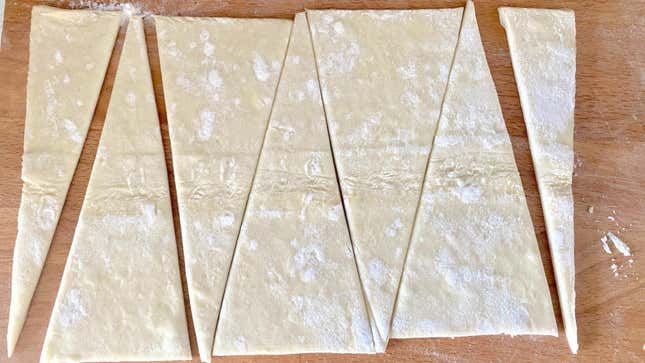My home isn’t a coffee shop, but my weekend morning routine would make you wonder. I take the necessary steps to brew coffee that makes me feel bougie, and I pair it with a snack that tastes like it could have a French name. No, I’m not about to laminate dough for a batch of 36 almond croissants. Instead, I make an imposter pastry, a certified faker’s croissant. And you can make it too. Use packaged puff pastry and make yourself a faux-ssant.
Make no mistake, puff pastry and actual croissant dough are quite different. There’s the matter of yeast-raised versus not yeast-raised, and the amount of folds involved during lamination, but let’s focus on the two things that matter most–intense buttery flavor, and flaky, puffy carbs. In this way, puff pastry and croissant dough are practically sisters. Thankfully, one is chillin’ in your grocery store freezer, and all the hard work is done for you.
You can make all of your favorite croissant-adjacent pastries at home whether you want them plain, chocolate, or almond. They all start off the same. Unwrap a thawed sheet of puff pastry on a lightly floured work surface. If there are any sticky spots, dab on a little flour. For a chocolate croissant, or chocolatine, I cut the roughly nine by nine-inch sheet into six equal rectangles.

Place two rows of semi-sweet chocolate pieces about an inch apart in the middle of the rectangle. Bakeries use chocolate batons for this purpose, but since I don’t have those in my fake home cafe, I lined up chocolate morsels. You could also cut chocolate sticks out of a chocolate bar. Note you should not use very expensive dark chocolate; it melts-out too much. The cheaper stuff is better because it holds its shape under high temperatures.

Fold one end of the pastry over one chocolate strip and keep on rolling over the second chocolate strip. Put it on a parchment-lined baking sheet, seam side down. Egg wash the top and bake according to the package directions, usually 400°F for about 15 minutes, or until well browned.

You can also make a chocolate croissant in the classic croissant configuration, like you would with a plain or almond croissant. With a full sheet of thawed puff pastry, cut the sheet two thirds of the way, so you end up with a sheet that’s nine-inches wide by six-inches tall. Save the excess strip for another use. Cut five alternating triangles out of the pastry. You’ll have two little half angles on the edges, save those for croutons.
Level-up your faux-ssant game:
Slice the middle of one triangle’s base and stretch the pastry to widen the base, the slice will open up to a notch. This improves the shape later on. If you’re making a plain croissant, tuck the notched side and roll it up, all the way to the point. If you’d like to add chocolate instead, put five or six morsels near the base and then roll it.

If you’re making an almond croissant, like I did in the picture, spread about a teaspoon of a simple almond paste, or frangipane, on the triangle. Then tuck the base and roll the pastry down to the point. Place the faux-ssants on a parchment lined baking sheet, point-end down, lightly egg wash the top, and top with slivered almonds if you have them. (Sadly, I didn’t.) Bake at 400°F for 10-15 minutes or until puffed and well browned.
Allow your cafe treats to cool on a wire rack for about five minutes before grabbing your latte and sitting in your favorite seat. You’re a regular here so everyone knows to “leave it open.” The following recipe is for an ultra simple, small batch almond paste, and it fills about four faux-ssants.
Simple Almond Paste
Table of Contents
Ingredients:
- 3 tablespoons almond flour
- 1 tablespoon sugar
- 1 tablespoon egg white
- ¼ teaspoon almond extract
In a small bowl, mix all of the ingredients together until a paste forms. Spread on puff pastry, or make a quick bostock almost toast.
